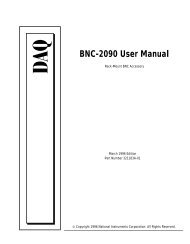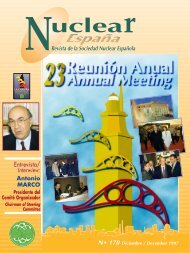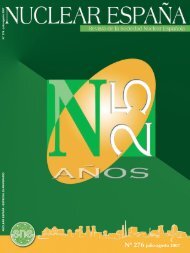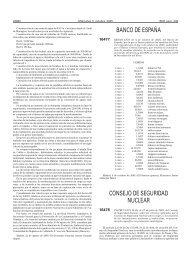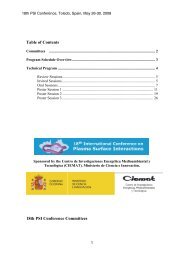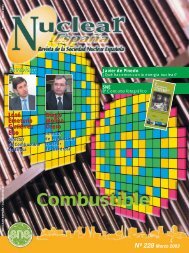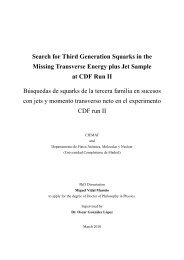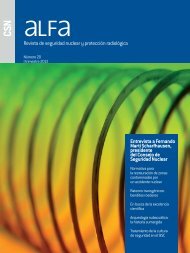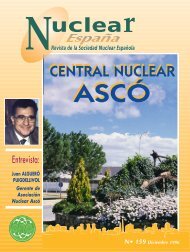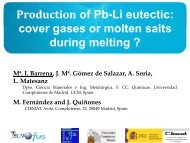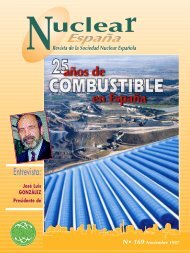EntrEntr evista/evista/ InterInter viewview
EntrEntr evista/evista/ InterInter viewview
EntrEntr evista/evista/ InterInter viewview
Create successful ePaper yourself
Turn your PDF publications into a flip-book with our unique Google optimized e-Paper software.
CENTRALES NUCLEARES/NUCLEAR POWER PLANTS<br />
VALORES DE LOS INDICADORES OBTENIDOS POR CN VANDELLÓS II EN 1999<br />
INDICATOR VALUES OBTAINED BY VANDELLÓS II NPP IN 1999<br />
Factor de Disponibilidad/Capability Factor: 83,3%<br />
Factor de Carga/Load Factor: 81,54%<br />
Disparos automáticos no programados por 7.000 crítico/ 2,8<br />
Reactor scrams per 7,000 critical hours:<br />
Funcionamiento de sistemas de seguridad/<br />
Safety System Operation:<br />
- Inyección de seguridad/ Safety injection: 0,002<br />
- Agua de alimentación auxiliar/ Auxiliary feedwater: 0,003<br />
- Suministro eléctrico de emergencia/ 0,008<br />
Emergency power supply:<br />
Eficiencia Térmica/ Thermal Performance: 99,6 %<br />
Fiabilidad del combustible/ Fuel Reliability:<br />
Exposición colectiva a la radiación/<br />
Collective Radiation Exposure:<br />
Respecto al índice de fiabilidad<br />
de combustible, decir que en el inicio<br />
del ciclo se ha roto la tendencia<br />
a la baja que habíamos tenido en<br />
años anteriores, como consecuencia<br />
de alguna fuga que ha situado el índice<br />
en un valor de 6,49 E -03 Ci/gr.<br />
a final de ano.<br />
OTRAS ACTIVIDADES,<br />
PROYECTOS Y MEJORAS<br />
En otro orden de cosas se debe resaltar<br />
que:<br />
• En fecha 1.4.99 entró en aplicación<br />
la Regla de Mantenimiento, como<br />
instrucción complementaria del<br />
PEP. El periodo de verificación y validación<br />
por el CSN está finalizado,<br />
habiendo entrado en vigor y siendo<br />
auditado todo el proceso por el<br />
CSN.<br />
• Se ha presentado la Revisión<br />
Periódica de Seguridad, como condición<br />
necesaria para la solicitud de<br />
renovación del PEP. En estos momentos<br />
está en fase de comentarios<br />
y aclaraciones a petición del CSN.<br />
• Se continúa con la Revisión de<br />
las Bases de Diseño y de Licenciamiento<br />
de la Central y su coherencia<br />
con el Informe Final de<br />
Seguridad. Trabajo que se prevé finalizar<br />
a mediados de este año.<br />
• Se sigue profundizando en la<br />
7,9 E-03 µCi/gr<br />
Volumen de residuos sólidos de baja actividad/ 34,98 m 3<br />
Low-level Solid Waste Volume:<br />
Índice químico/ Chemical Index: 1,56<br />
Tasa de accidentes con horas perdidas/ 0,94<br />
Accident Rate with Lost Hours:<br />
1035,69 mSv-persona<br />
1035.69 mSv-person<br />
mejora de las Especificaciones de<br />
Funcionamiento según NUREG-<br />
1431," line-item improvements" y<br />
las Generic Letters.<br />
• Se sigue trabajando en las propuestas<br />
de mejora de las Guías de<br />
Operación de Emergencia y<br />
Procedimientos de Operación en<br />
general, así como en las Guías de<br />
Repuesta frente a accidentes severos<br />
(Accident Managment).<br />
• En cuanto a la optimización del<br />
Programa de Mantenimiento mediante<br />
Metodología RCM (Reliability<br />
Centered Maintenance), después de<br />
la formación general y específica y<br />
tras la personalización de la herramienta<br />
informática HAMA, se han<br />
preparado los procedimientos para<br />
aplicación.<br />
Durante el segundo semestre del<br />
año 1999 se han realizado 9<br />
Sistemas, analizándose el mantenimiento<br />
actual y definiendo el mantenimiento<br />
recomendado futuro en<br />
función de criterios de riesgo y economía.<br />
En la definición del mantenimiento<br />
recomendado han participado<br />
todos los servicios implicados<br />
(Operación, Especialidades de<br />
Mantenimiento e Ingeniería de<br />
Sistemas) liderados por la Oficina<br />
Técnica de Mantenimiento. Esta primera<br />
fase de optimización del mantenimiento<br />
en Vandellós II es la base<br />
comments and clarifications requested<br />
by the CSN.<br />
• Review of the plant’s Design Bases<br />
and Licensing and their consistency<br />
with the Final Safety Report continues.<br />
It is expected that this job will be<br />
completed in the middle of this year.<br />
• There is a continued focus on<br />
improving the Operating Specifications<br />
as per NUREG-1431, line-item<br />
improvements and the Generic Letters.<br />
• Work continues on the proposed<br />
improvements of the Emergency<br />
Operation Guidelines and Operating<br />
Procedures in general, as well as on<br />
the Severe Accident Response<br />
Guidelines (Accident Management).<br />
• As regards optimization of the<br />
Maintenance Program through the<br />
RCM (Reliability Centered Maintenance)<br />
Methodology, the application<br />
procedures were prepared after general<br />
and specific training had been<br />
provided and the HAMA computer tool<br />
customized.<br />
During the second half of 1999, nine<br />
systems were analyzed to determine<br />
current maintenance and define<br />
recommended maintenance in the<br />
future in terms of risk and economic<br />
criteria. All involved services<br />
(Operation, Maintenance Specialties<br />
and Systems Engineering) took part in<br />
the recommended maintenance<br />
definition under the direction of the<br />
Technical Maintenance Office. This first phase of<br />
maintenance optimization in Vandellós II is the basis<br />
and core part of the corporate aim for Ascó and<br />
Vanellós II NPPs.<br />
• The SIGEVI (Life Management System) Project is<br />
being implemented in CNV II to complete loading of<br />
historical data and user training. All the specific<br />
modules of the Plant’s most significant equipment<br />
were covered during 1999. This is an open structure<br />
application that can be tailored to each Plant, it<br />
provides suitable tools for analyzing trends and<br />
evaluating remaining lifetime, and it has great<br />
potential from the standpoint of both Engineering<br />
and Maintenance.<br />
• The original Process Computer was replaced by<br />
an OVATION type distributed system that has been<br />
integrated with other systems such as the Turbine<br />
Electrohydraulic Control (DEH) System, the Graphic<br />
Interface Simulator (SGI), and other PLC- and PCbased<br />
monitoring systems.<br />
This change has also improved the Safety<br />
Parameter Display System (SPDS), which it supports.<br />
The new computer has been in use since the<br />
beginning of the current cycle.<br />
• In addition, work continued throughout the year<br />
on preparation of all actions established by the<br />
Master Plan for addressing the Y2K effect.<br />
ORGANIZATIONAL ASPECTS<br />
The merger of the Ascó NPP and Vandellós-II NPP<br />
organizations required that the Plant Managements<br />
have a common approach to objectives, which was<br />
reflected in a Joint Action Plan, in order to achieve<br />
functional integration by grouping together those<br />
basic criteria that will help ANA and CNV II<br />
successfully organize and act as if they were a single<br />
enterprise in those areas where this is possible.<br />
In this respect, objectives, aims, managers and<br />
action plans have been established by Areas of<br />
A b r i l 2 0 0 0<br />
R e v i s t a S N E




